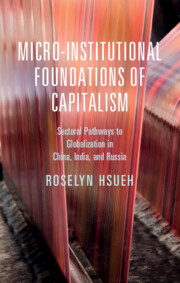Book contents
- Micro-institutional Foundations of Capitalism
- Micro-institutional Foundations of Capitalism
- Copyright page
- Dedication
- Contents
- Figures
- Tables
- Acknowledgments
- Part I Politics of Market Governance
- Part II Nations and Sectors: Patterns of Market Governance
- 3 China and Sectoral Variation
- 4 Security Imperatives, Infrastructural Development, and High-Tech Sectors
- 5 Political Stability, Local Goals, and Labor-Intensive Sectors
- 6 India and Sectoral Variation
- 7 Pro-Liberalization Transnational Business and High-Tech Services
- 8 Political Legitimacy, Economic Stability, and Labor-Intensive Small-Scale Sectors
- 9 Russia and Sectoral Variation
- 10 National Security and Infrastructure and Resource Sectors
- 11 Regional Development and Labor-Intensive Sectors
- Part III National Configurations of Sectoral Models
- Bibliography
- Index
8 - Political Legitimacy, Economic Stability, and Labor-Intensive Small-Scale Sectors
Centralized Governance in Indian Textiles
from Part II - Nations and Sectors: Patterns of Market Governance
Published online by Cambridge University Press: 16 June 2022
- Micro-institutional Foundations of Capitalism
- Micro-institutional Foundations of Capitalism
- Copyright page
- Dedication
- Contents
- Figures
- Tables
- Acknowledgments
- Part I Politics of Market Governance
- Part II Nations and Sectors: Patterns of Market Governance
- 3 China and Sectoral Variation
- 4 Security Imperatives, Infrastructural Development, and High-Tech Sectors
- 5 Political Stability, Local Goals, and Labor-Intensive Sectors
- 6 India and Sectoral Variation
- 7 Pro-Liberalization Transnational Business and High-Tech Services
- 8 Political Legitimacy, Economic Stability, and Labor-Intensive Small-Scale Sectors
- 9 Russia and Sectoral Variation
- 10 National Security and Infrastructure and Resource Sectors
- 11 Regional Development and Labor-Intensive Sectors
- Part III National Configurations of Sectoral Models
- Bibliography
- Index
Summary
This chapter shows how in parallel to the regulated governance in telecommunications uncovered in Chapter 7, the perceived strategic value of labor-intensive industries dominated by rural small-scale producers, showcased by textiles, for national self-reliance and neoliberal development, shape the centralized governance by the Indian government. The cross-time sector and company case studies reveal that at a time when centralized market coordination in labor-intensive, less value-added textiles is eliminated around the world, India created a central ministry and other sector-specific bureaucracies in textiles associated with nationalist narratives of Gandhian Swadeshi self-reliance in the 1980s following internal political and economic crises. Endowed with limited resources and regulatory capacity, the centralized governance of the textile ministry has introduced extensive competition in the neoliberal era and deliberately intervened in market developments. In addition to subsidizing industrial upgrading and deregulating market entry, business scope, and trade, the textile ministry has nationalized large-scale textile mills of the organized sector during economic slowdowns. Moreover, fiscal and protectionist trade policies have also cushioned the survival of small-scale, labor-intensive handlooms in apparel and clothing and the highly polluting power looms dominant in more capital-intensive technical textiles even as the state promotes export-oriented industrialization.
Keywords
- Type
- Chapter
- Information
- Micro-institutional Foundations of Capitalism , pp. 213 - 242Publisher: Cambridge University PressPrint publication year: 2022



